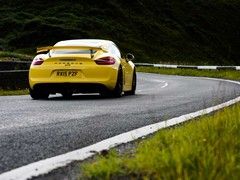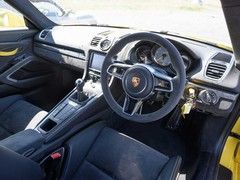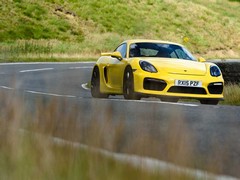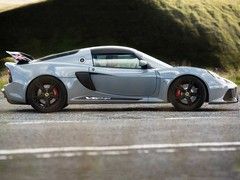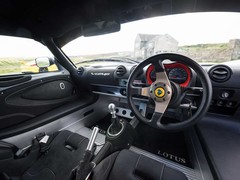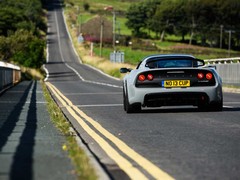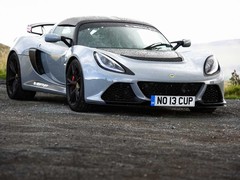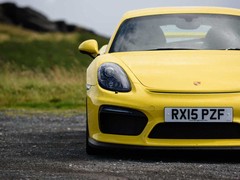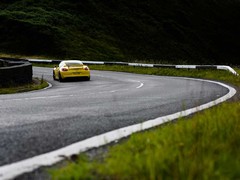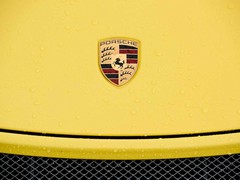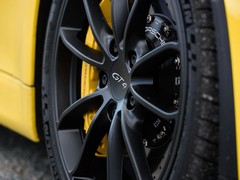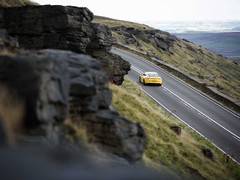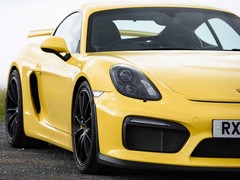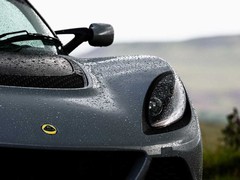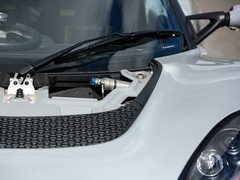Porsche Cayman GT4 vs. Lotus Exige V6 Cup
The best Porsche you can't buy against the Lotus you might just want to consider as an alternative - but is it really worthy?

This time it works though. The Cayman GT4 trades on the track focused input of the division that builds GT3s alongside their Cup and RSR race equivalents. And the Exige Cup is - technically - a Lotus Motorsport product, a roll cage away from eligibility to race in Lotus Cup championships held around the world.
Starting price for the Exige Cup is £62,994 while the Cayman, if you could buy it (which you can't), ostensibly starts at £64,451. Both numbers can be easily inflated via the options list though, our PHer supplied Exige costing over £70K while our GT4 press car with all the toys tops £80,000.
The Cayman has 385hp and 310lb ft from a 3.8-litre normally aspirated flat-six while, as tested, the Lotus's 3.5-litre supercharged V6 does 350hp and 295lb ft in a car weighing nearly a quarter of a tonne less. Lotus has also just confirmed an updated Cup with 360hp plus the same starting price and it would seem there is more where that came from on the way. For now both are manual-only, track-tyre shod circuit shredders with spanner-based adjustment for the fettlers but a no-nonsense purist streak straight out of the box. This test isn't about lap times and number crunching though, rather an investigation of which can work better on your traditional British back road, in this case the brutally bumpy ones criss-crossing Saddleworth Moor.
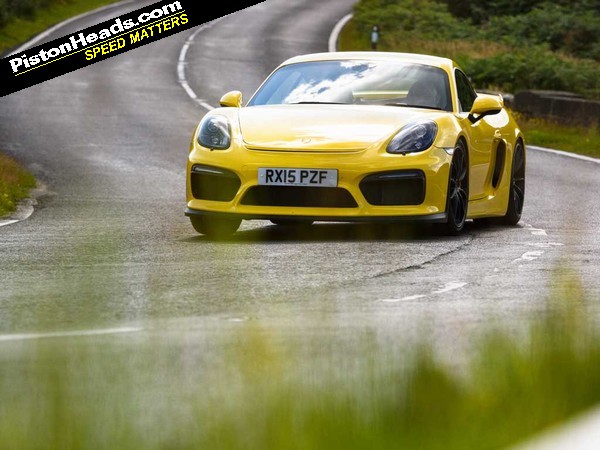
The 991 GT3 is not like the cars Porsche's GT department used to make. An incredibly impressive piece of kit and, if you're man enough to go there, a very, very grown-up driving proposition too. But gizmos like PDK and four-wheel steering open the door to the posers and wannabes natural selection would previously have weeded out in as long as it took them to stall single-mass flywheel against hair-trigger clutch.
The Cayman GT4 IS the kind of car Porsche's GT department used to make. Indeed, you wonder if this was the deal Preuninger and his team made at the crossroads, Robert Johnson style. We'll build you a GT3 for the mainstream. But we get to really express our talents in a car built for the die-hards disillusioned with the new direction for the 911.
And that's exactly who bought it. Apparently swallowing up the entire allocation, leaving none for the rest of us. Here, in a Bullseye style 'look at what you could have won' is what you're missing out on. In short, the answer to all the criticisms we've thrown at the 991 and latest Caymans and Boxsters. Well, nearly all.
Starting at the front the GT3 front suspension, smaller (and completely unadorned) wheel and other changes mean there's none of the mush in the steering seen in 'civilian' Porsches. Yes, it's electrically assisted. And, no, there isn't the feel of the older cars. But it's brilliantly weighted, predictable and absolutely resolute in its reaction to your inputs. Point front end. It goes. The murmurs of feedback as the front wheels track cambers or load and unload aren't as clear as they once were but for an electric system it's as good as it gets.
The natural balance of the Cayman, flat stance and the brilliant damping mean turn-in a 911 driver could only dream of. Porsche admits the standard setting of the dampers is the one used for the 'ring times and road driving, the firmer PASM mode only really for super smooth tracks. This and the fact GT Porsches permit a 15 per cent overspeed on the rear wheels even with everything fully on means the only mode button you really need press is the loud exhaust setting. Turn the nannies off if you will but there is movement aplenty even with them in place. With experience of this and the Cup tyres in the GT3 it'll be interesting to drive this car in the wet...
Saying that the beauty of the GT4 is its ability to overlap the various corner phases and give you confidence to play with its balance even at vaguely civilised speeds. Regular Porsches just don't do this any more but in the GT4 you can relish the sense of picking up the throttle before you've even started winding the lock off, rear axle working in partnership with the front to push the car into the turn. Meaning by the time you come to exit you're already in the engine's howling sweet spot as the lock releases, the relaxed stability control permitting just the subtlest sense of rotation under power. That you feel this even with Cup rubber on a dry road is a measure of how detailed the feedback is.
Then of course there's the manual gearbox. The stubby, Alcantara covered shifter has a lovely, mechanical positivity and the crispness of the throttle response demands pinpoint accuracy if you're to time your revs and blips to perfection. Sport mode does it for you but, really, that's just cheating. The ratios? Preuninger will insist the long second is there to give you a single overtaking gear but, without wishing to incriminate ourselves, it proves not quite long enough and a lower third gear would give you more headroom. At vaguely realistic 'fast road' pace you'll rarely be out of second and third, necessitating constant cross-plane shifts when to and fro between third and fourth would be faster and more intuitive. It doesn't ruin the driving experience, but it is a very real flaw. Preuninger can scowl all he likes; on these roads a shorter final drive would really let the GT4 off its leash.
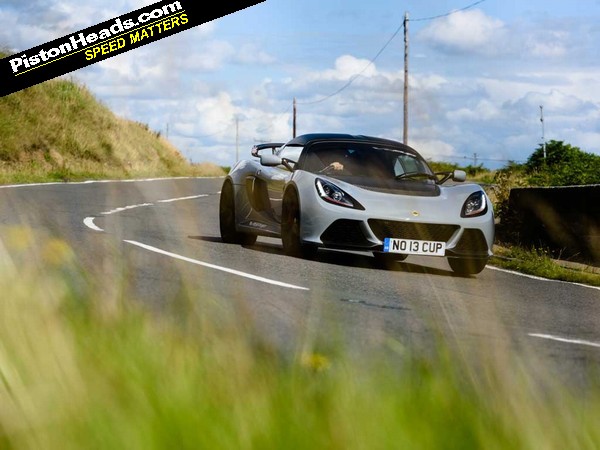
The Cayman might have a half cage in the back and natty little fabric door releases. But its track pretensions are just that, given the lashings of Alcantara, contrast stitching and toys found in the cabin. The Lotus is the real thing though, kill switch and extinguisher button occupying the space where you'd usually find a radio and only the bare minimum of the aluminium tub covered in any trim whatsoever.
This is a more honest expression of Lotus values than you get in the Evora 400, proper minimalism but carried off with style too. The removable steering wheel is beautiful; alongside the gearstick and the pedals you don't really need to focus on anything else.
On the road the V6 Exige is a more muscular and physical piece of kit than the old four-cylinder one. More potent, for sure, but not quite as feral or crazed. But it's still 230kg less than the Porsche. This shows as you swap from one to the other, the supercharged Toyota engine having a more elastic power delivery than the crisp, normally aspirated Porsche in the sense that you stretch it and then - twang! - you're properly catapulted forward as if fired off the front of an aircraft carrier. For all that talk the gearing doesn't feel noticeably shorter than the Porsche but the rev range is tighter and the delivery punchier, meaning you spend more time flicking between third and fourth with second only really necessary in properly tight corners. Which is just as well, because the shift - though better than many Lotuses - still isn't quite as positive as the Cayman's.
On these violently bumpy Pennine roads the steering requires a firm hand. It doesn't kick back like a 4C but the cambers and bumps are such that you need to be assertive to even maintain a straight and level course. Corners will have the sinews in your forearms straining, the front axle dictating pace more than it does in the Porsche. If you're greedy with the entry speed it feels ready to push on, more gas only exacerbating it where the diff-equipped Cayman has that lovely sense of throttle adjustability. Your only option is to lift momentarily to tuck it back in; a split second off the power compared with the Porsche but enough compartmentalise steering and throttle into separate tasks rather than merging one into the other. The pick-up and lack of weight mean you'll make up the ground in an instant but it's more about point and squirt and less about flow than you might expect of a Lotus.
The roads are sufficiently bumpy that, were this not a privately-owned car, you'd be considering dialling in a bit more damping via the clickers on the Nitrons' remote reservoirs. Optional Ohlins are available but as-is the Lotus actually struggles with the violent compressions more than the Porsche, which is a bit of an upset for the home team. Indeed, at times it actually feels a little unruly, diagonal bumps pitching the car into a frankly alarming corkscrewing motion. The Cup's hardpoints have more adjustment available than the standard V6 though, meaning geometry and damping can all be fiddled with according to need. On the day though it's simply not as flat and composed as the Porsche; it'll still carry comparable pace but your palms are sweatier doing so.
As you'd expect, it's a much more sensory experience driving this car fast. The creaks through the structure, the whiff of fuel, the sneezes and shrieks of the supercharger - even the squelching of the dampers through big bumps - you get it all. Next time we get these two back to back it needs to involve a track and a stopwatch...

First shock is the car that performs best on these very British roads isn't the Lotus, at least as-is. Not everyone wants to fiddle with clicker adjusters and spanners and, without any tweaking, the Porsche just gobbled up the very worst these vicious roads could throw at it. The engine is glorious and the decision to keep it manual only is inspired self-selection for those who'll really appreciate its subtleties.
But. Even if you wanted one your Porsche dealer can't sell you one - exactly the situation our Lotus owner found himself in.
So the Lotus is the silver medal for those who didn't win the race to get a Cayman? Yes and no. Like that guy who self consciously wears his race overalls to the track day briefing there's a whiff of pretension about the Porsche's track garnish, given it's not really stripped back and minimalist at all. When Sport Auto's reaction to driving it back to back with a standard Exige is a narrow points victory for the Lotus and cry for a 'proper' pared back, track-spec RS version you know there's something in this.
The Cayman still taps into enough track influence to reward like no other Porsche on sale and make every day feel like a track day, even if it's not. The Lotus, on the other hand, is a pure adrenaline hit, a bit raw and properly intense but always thrilling thanks to a pleasing imbalance of power to weight. And if the Cup is a bit extreme there's always the standard V6 S. Either way, if Stuttgart's caution about GT4 volumes has given you fear of missing out it's credit to Lotus that the Exige offers a genuinely viable alternative, even against Porsche at the absolute top of its game.
LOTUS EXIGE V6 CUP
Engine: 3,456cc V6, supercharged
Transmission: 6-speed manual, rear-wheel drive
Power (hp): 350@7,000rpm
Torque (lb ft): 295@4,500rpm
0-62mph: c. 3.8sec
Top speed: c. 171mph
Weight: 1,110kg (without driver, depending on final spec)
MPG: 28mpg (NEDC combined)*
CO2: 236g/km*
Price: £62,994 (basic price inc. VAT, fully road legal and with limited warranty)
*Figures for standard Exige S
PORSCHE CAYMAN GT4
Engine: 3,800cc flat-6
Transmission: 6-speed manual, rear-wheel drive, limited-slip differential
Power (hp): 385@7,400rpm
Torque (lb ft): 310@4,750rpm
0-62mph: 4.4sec
Top speed: 182mph
Weight: 1,415kg (EU with driver; 1,340kg DIN without driver)
MPG: 27.4mpg (NEDC combined)
CO2: 238g/km
Price: £64,451 (before options, £81,551 as tested, comprising Porsche Ceramic Composite Brakes £4,977; Clubsport package £2,670; fixed bucket seats £1,907; black painted wheels £393; centre console carbon trim £341; black leather interior with contrast stitching £1,344; Porsche Communication Management inc. sat nav £2,141; Sport Chrono £1,085; telephone module for PCM £527; two-zone climate control £518; Sound Package Plus £396; Porsche Dynamic Light System
[Photos: Sim Mainey]
Gassing Station | General Gassing | Top of Page | What's New | My Stuff


